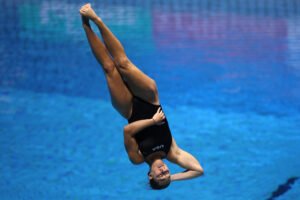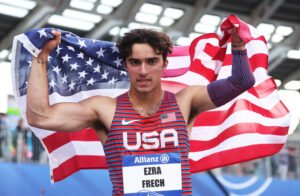When it comes to showcasing elegance, athleticism, and skill in the water, diving stands as one of the most captivating sports, and USA Diving has long held a prominent position on the global stage. From the Olympics to international competitions, the USA’s diving athletes have continued to raise the bar, excelling with stunning performances that combine physical precision with a touch of artistry. But what’s behind the enduring success of USA Diving? Let’s dive into the world of competitive diving in the United States, exploring the rich history, challenges, and the future of this exciting sport.
Table of Contents
ToggleA Brief History of USA Diving

Diving as an organized sport began to gain traction in the United States in the early 20th century. With origins rooted in gymnastics, the sport quickly captured the attention of American sports enthusiasts, especially as it became an Olympic event in the 1904 St. Louis Games. Over time, diving clubs, programs, and events sprouted across the country, laying the groundwork for what would become USA Diving.
Diving was officially established in 1981 as the national governing body for the sport in the United States, helping to streamline the training and support of diving athletes at all levels. The organization has played a pivotal role in fostering talent by partnering with colleges, local diving clubs, and community organizations. Through these collaborations, USA Diving has been able to train world-class athletes who have gone on to compete in the Olympic Games, World Championships, and Pan American Games, amassing medals and pushing the sport’s boundaries.
The Core of USA Diving: Training and Technique
Competitive diving requires more than just physical prowess; it demands a blend of precision, mental toughness, and courage. Divers must master intricate techniques and execute them flawlessly from high platforms or springboards, twisting and flipping in mid-air before entering the water with as little splash as possible.
USA Diving supports its athletes with high-quality coaching and access to state-of-the-art facilities across the country. Training camps are designed to help divers perfect their techniques, focusing on every aspect of performance, from air control to body alignment and water entry. Coaches within the USA Diving system are among the most highly regarded in the sport, known for their expertise and ability to push divers to new heights while prioritizing safety and injury prevention.
Types of Diving Competitions

USA Diving competitions are held across several formats, with two major categories:
Springboard Diving – This includes both 1-meter and 3-meter events. Divers use a flexible board to propel themselves into the air, using the bounce to gain height and execute their dives.
Platform Diving – These dives are performed from a fixed platform 10 meters above the water. Due to the height, platform diving demands excellent aerial skills and body control, as divers often complete multiple twists and flips before hitting the water.
Each type of diving comes with its own set of challenges, but they all require split-second timing and flawless technique. USA Diving events feature both individual and synchronized dives, where teams of two perform coordinated dives, showcasing the teamwork and precise timing that adds an extra layer of difficulty to the sport.
Notable American Divers and Their Impact

Over the years, many American divers have earned international acclaim, inspiring future generations. Names like Greg Louganis, the Olympic gold medalist whose remarkable skill and resilience have made him a diving icon, and Laura Wilkinson, who won gold in 2000 despite an injury, stand as testament to the strength of USA Diving. In recent years, divers like David Boudia and Steele Johnson have continued to represent the U.S. on the world stage, bringing home medals and continuing the tradition of excellence in the sport.
These athletes have had an indelible impact not only on the medal count but also on the sport’s visibility in the United States, encouraging more young people to explore diving. Diving places a strong emphasis on fostering young talent, offering developmental programs that give aspiring divers a chance to train and compete at national levels, potentially leading to international competitions.
Challenges and the Road Ahead
Like any sport, competitive diving faces its share of challenges. High training costs, rigorous schedules, and the physical demands of the sport can be challenging for athletes and their families. In addition, diving requires specialized facilities, making it a sport that can be harder to access than others. However, USA Diving has worked hard to expand the sport’s reach, aiming to introduce more young people to diving through partnerships, scholarships, and community programs.
Looking ahead, USA Diving has committed to increasing the visibility and accessibility of the sport, including initiatives that promote diversity and inclusion. As diving continues to evolve, with athletes pushing the limits of what’s possible in the air, the U.S. aims to remain a powerhouse in international diving.
How to Get Involved with Diving
For those interested in joining Diving, there are a variety of ways to get involved, from recreational diving to competitive events. Local diving clubs often offer beginner classes, and USA Diving provides resources and support for aspiring divers looking to improve their skills. Whether you’re a young diver with Olympic dreams or a parent wanting to support your child’s interest in the sport, USA Diving’s network of coaches and clubs across the country can provide the guidance you need.
In addition, fans and supporters can watch USA Diving events at both national and international levels, with competitions streamed online and broadcasted on major sports networks. Spectators have the chance to witness the thrill and artistry of the sport, cheering on divers who, with each twist and turn, represent the pinnacle of American athleticism and dedication.
In Summary
USA Diving has not only built a legacy of producing world-class athletes but also fostered a community where dedication to precision, excellence, and resilience are celebrated. Through its commitment to supporting divers at every stage and promoting the sport to new audiences, USA Diving continues to inspire, innovate, and achieve. The sport’s future in the U.S. shines bright, buoyed by a strong legacy and the promise of new talents ready to dive into greatness.
FAQs about USA Diving
What is USA Diving?
USA Diving is the national governing body for the sport of diving in the United States. It oversees competitive diving events, training programs, and athlete development from grassroots to elite levels, including the U.S. Olympic Diving Team.
How does someone get started in diving with USA Diving?
Beginners can join USA Diving through local diving clubs, which offer training programs for all ages and skill levels. Many clubs are affiliated with USA Diving and provide structured pathways from introductory classes to competitive teams.
What types of diving events does USA Diving organize?
Diving organizes various diving events, including springboard and platform diving, at both individual and synchronized levels. These events are featured in local, regional, national, and international competitions.
How does USA Diving select athletes for the Olympics?
Olympic team selections are made through a series of trials, where top divers compete for limited spots on the team. USA Diving oversees the qualification process, selecting the athletes who perform best at these trials to represent the U.S. at the Olympics.
Are there age requirements for joining USA Diving?
There are no strict age requirements to join USA Diving, as there are programs for young beginners as well as older teens and adults. Many competitive divers start training at a young age, but USA Diving welcomes athletes of all ages interested in learning the sport.
What support does USA Diving provide to its athletes?
USA Diving provides athletes with access to high-level coaching, training facilities, and resources, including sports psychology and physical therapy support. The organization also hosts clinics and training camps and offers scholarships and development programs for young athletes.

